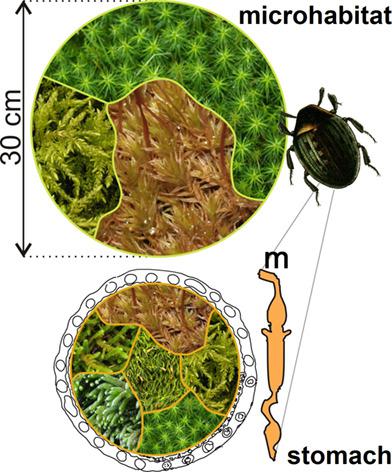当前位置:
X-MOL 学术
›
Insect Conserv. Divers.
›
论文详情
Our official English website, www.x-mol.net, welcomes your
feedback! (Note: you will need to create a separate account there.)
Don't eat where you sleep: unexpected diversity of food web for beetles feeding on mosses
Insect Conservation and Diversity ( IF 3.2 ) Pub Date : 2020-10-08 , DOI: 10.1111/icad.12453 Petr Pyszko 1 , Vítězslav Plášek 1 , Pavel Drozd 1
中文翻译:

不要在睡觉的地方吃饭:甲虫以苔藓为食的食物网异常丰富
更新日期:2020-10-08
Insect Conservation and Diversity ( IF 3.2 ) Pub Date : 2020-10-08 , DOI: 10.1111/icad.12453 Petr Pyszko 1 , Vítězslav Plášek 1 , Pavel Drozd 1
Affiliation

|
- Bryophytes represent favourable habitats for many arthropods, but their utilisation as a food source is marginal. While one of the largest monophyletic groups that represent obligatory bryophyte consumers are the Byrrhidae, host ranges for species in this group of beetles remain largely unknown due to their cryptic appearance and rarity. The occasional notes of ‘associated’ moss species that do exist are related to where Byrrhidae were found and not to diet analysis. Because the majority of Byrrhidae are stenobionts with limited dispersal, the assumption that associated moss species are also used as food is a useful hypothesis.
- To test this hypothesis, 328 individuals were sampled from the species: Cytilus sericeus, Byrrhus fasciatus, Byrrhus pilula, and Byrrhus glabratus. Mosses from both the stomachs and the immediate microhabitats of beetles were determined with the aim of (i) identifying their host range and (ii) testing whether the moss species from microhabitats in which beetles were collected were also found in their stomachs.
- Almost 40 bryophyte species were found in beetle stomachs and accumulation curves for all beetle species failed to achieve asymptotes, together showing that all species are highly polyphagous.
- Although a strong general correlation existed between moss consumption and occupation, discrepancies were present at the individual level with there being considerably higher moss species richness in beetle stomachs than in their immediate microhabitats. Our results question the assumption that bryophyte occupancy and consumption can be used interchangeably when studying host use in these insects.
中文翻译:

不要在睡觉的地方吃饭:甲虫以苔藓为食的食物网异常丰富
- 苔藓植物是许多节肢动物的有利栖息地,但它们作为食物来源的利用却微不足道。代表必需的苔藓植物消费者的最大的单系统种群之一是白rrh科,但由于其隐秘的外观和稀有性,这一类甲虫的物种寄主范围仍然不为人所知。偶尔存在的“伴生”苔藓种的音符与发现白痢科的地方有关,而与饮食分析无关。由于大多数白痢科是具有有限扩散性的鳞茎纲动物,因此将相关的苔藓物种也用作食物的假设是一个有用的假设。
- 为了验证该假设,从以下物种中采样了328个个体:莎草(Cytilus sericeus),筋膜白带(Byrrhus fasciatus),毛头草(Byrrhus pilula)和白草(Byrrhus glabratus)。确定了胃和甲虫的直接微生境中的苔藓,目的是(i)确定它们的寄主范围,以及(ii)测试在它们的胃中是否也发现了来自收集了甲虫的微生境中的苔藓物种。
- 在甲虫胃中发现了近40种苔藓植物物种,所有甲虫物种的积累曲线均未达到渐近线,这表明所有物种均为高度食虫性。
- 尽管苔藓的消费与职业之间存在着很强的一般相关性,但个体水平存在差异,甲虫胃中的苔藓物种丰富度远高于其直接的微生境。我们的结果对这样的假设提出了质疑,即在研究这些昆虫的宿主使用时,苔藓植物的占用和消耗可以互换使用。











































 京公网安备 11010802027423号
京公网安备 11010802027423号